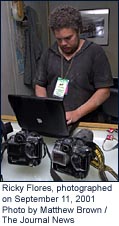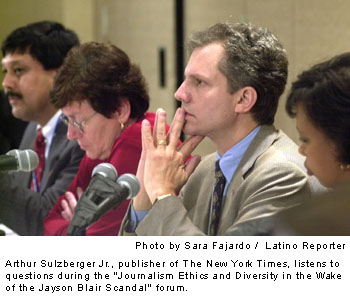|
|
||||
For me, photography represented a way to understand what was taking place around me when I was growing up in the South Bronx. I was a young first generation Puerto Rican descendent born at Bellevue Hospital, historically and infamously known for treatment of psychiatric patients. At the age of five, I lost my father who died of bronchial asthma. Shortly afterward my mother and I moved to the South Bronx. It was a turbulent time. The Young Lords were active in my community but on the decline. Landlords defaulted on their taxes and abandoned their apartment buildings, or burned down the buildings for insurance. Street gangs were the norm where I lived on Fox and Longwood Avenue, and one gang, the Savage Skulls, received national notoriety because of the violent and tragic death of one of a group of brothers at the hands of a rival gang. Anger fueled by our abandonment by the city was commonplace and was expressed by turning over abandoned cars or throwing other debris into the middle of the street and setting it on fire. We could always count on the Fire Department to come, but no one else, and firefighters would continue to have a profound influence on my life. Eventually, troops of psychologists, psychiatrists and social workers descended on my neighborhood to try to understand the destruction of an entire community. In the midst of this I as well always wondered why these things were taking place in my community. As I hit my eighteenth birthday, a friend of mine turned me on to photography and with a small inheritance that I received from the death of my father I was able to purchase my first camera. In the beginning it was natural for me take photographs of my friends and family at their homes, on the streets or at the local businesses. What I didn’t know then was that I was making a historical document about life in the South Bronx from a perspective that was not seen from people from outside of the community.
When I was invited along with other professionals to act as supervisory staff for the Latino Reporter, a convention-centered student newspaper for the National Association of Hispanic Journalists which was holding a convention in New York City in June of 2003, I accepted, although at the time I was not entirely clear as to why I did so. What followed was one of the most intense learning
and teaching experiences of my life. For a whole week I worked with
Carlos Osorio, a photographer for the Associated Press and four young
photojournalists from around the country. We covered a host of issues
ranging from street life on 42nd street to life in the surrounding communities
from Ground Zero to the Lower East Side to Washington Heights. In the
midst of this, New York Times Publisher Arthur Sulzberger Jr., addressed
a workshop at the convention on "Journalism Ethics and Diversity
in the Wake of the Jayson Blair Scandal." Although the Jayson Blair scandal has raised questions on how people of color are treated in the newsroom, and whether it was favoritism or maybe lack of support, the general consensus was that this was an individual with a dual life in the major newsroom who self-destructed in a very public way. Color had no role in this incident, only poor management. But the tale remains a cautionary one for those of us who are trying to break into or work within this industry. No issue, angle or slant will be left unexplored if we fail as journalists. Today we write or shoot the lead story; the next day we can very well become the lead.
© Ricky Flores |
|
|
Write a Letter
to the Editor |

 E
E When
I entered Empire State college, I began to re-examine my life as a Puerto
Rican man from the South Bronx. I started to realize the importance
of my work, documenting life in my community. During that period I benefited
from mentoring from several Professors of photography and community
activists who were active within my community or within the world of
photography. The camera became a tool to understand what was taking
place around me. Since that time it has been a means to explore a wide
variety of subjects and issues that have caught my attention.
When
I entered Empire State college, I began to re-examine my life as a Puerto
Rican man from the South Bronx. I started to realize the importance
of my work, documenting life in my community. During that period I benefited
from mentoring from several Professors of photography and community
activists who were active within my community or within the world of
photography. The camera became a tool to understand what was taking
place around me. Since that time it has been a means to explore a wide
variety of subjects and issues that have caught my attention. The
fallout of the Jayson Blair incident has had a profound impact in newsrooms
around the nation. The professionals who staffed and supervised the
students felt that we needed to explore the issues of ethics and the
impact that the scandal may have on people of color. I struggled with
wanting to cover these issues on my own or turning them over to young
photographers who wanted to be able to prove themselves capable of the
task. . Carlos and I fought with them everyday; we cajoled, tutored,
pushed and yelled to make them understand the importance of the opportunity
that was being presented to them, and something wonderful then happened,
they all came through it in ways that was totally unexpected and breath
taking. Through the eyes of the students we received a lesson in Journalism
101. Our paper was called by the New York Post, requesting our student
reporter notes on the Sulzberger’s talk. The editor who responded
politely and firmly refused and instructed them to pick up a copy of
the Latino Reporter the next day. Our paper was displayed and quoted
on CSPAN which taped the Sulzberger talk. USA Today ran an article on
their lifestyle section on the Latino Reporter.
The
fallout of the Jayson Blair incident has had a profound impact in newsrooms
around the nation. The professionals who staffed and supervised the
students felt that we needed to explore the issues of ethics and the
impact that the scandal may have on people of color. I struggled with
wanting to cover these issues on my own or turning them over to young
photographers who wanted to be able to prove themselves capable of the
task. . Carlos and I fought with them everyday; we cajoled, tutored,
pushed and yelled to make them understand the importance of the opportunity
that was being presented to them, and something wonderful then happened,
they all came through it in ways that was totally unexpected and breath
taking. Through the eyes of the students we received a lesson in Journalism
101. Our paper was called by the New York Post, requesting our student
reporter notes on the Sulzberger’s talk. The editor who responded
politely and firmly refused and instructed them to pick up a copy of
the Latino Reporter the next day. Our paper was displayed and quoted
on CSPAN which taped the Sulzberger talk. USA Today ran an article on
their lifestyle section on the Latino Reporter. I
look at that week with a sense of profound pride that the future of
our industry is in good hands. Our small band of photojournalists and
journalists clearly understand why they are in the business, one that
is often left thankless and belittled by our very own. They share a
mission and purpose for doing what we do on a daily basis. More importantly
they see real value in the work, despite the damage that commercial
news ventures have been doing to our industry. I walked away wanting
to influence those of us who have not had the opportunity to take the
chance and share knowledge with those that are coming up. The rewards
and the stakes are great: we either let future photojournalists capitulate
to the needs of large corporate newspapers and magazines or we instill
in them a sense of mission and a vision of how the world really is and
how it should be.
I
look at that week with a sense of profound pride that the future of
our industry is in good hands. Our small band of photojournalists and
journalists clearly understand why they are in the business, one that
is often left thankless and belittled by our very own. They share a
mission and purpose for doing what we do on a daily basis. More importantly
they see real value in the work, despite the damage that commercial
news ventures have been doing to our industry. I walked away wanting
to influence those of us who have not had the opportunity to take the
chance and share knowledge with those that are coming up. The rewards
and the stakes are great: we either let future photojournalists capitulate
to the needs of large corporate newspapers and magazines or we instill
in them a sense of mission and a vision of how the world really is and
how it should be.